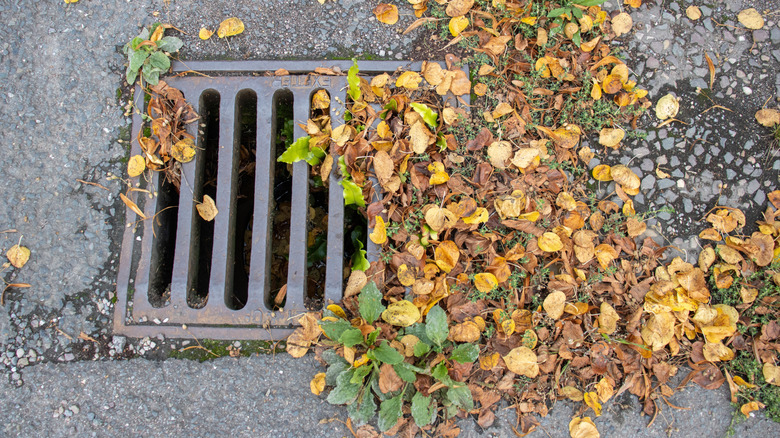These Are The Tools You Need To Clear Drain Clogs The Right Way This Fall
We may receive a commission on purchases made from links.
With the onset of fall, many of us must get to work raking, bagging, and clearing our yards of leaf litter. Fortunately, there are plenty of tools at our disposal, and many of them, such as electric leaf blowers from Ryobi, have taken the place of the noisy gas-powered tools of old. Yet while most people are well-equipped to clear their yards, clearing clogged outdoor drains requires a different set of tools.
The primary tool you'll need is a drain auger, sometimes called a drain snake or plumber's snake. Basically, a drain auger is a metal cable wrapped on a spool with a coiled, spring-shaped auger head at its tip. To use it, you feed the cable into the drain until it meets the blockage. Then, you spin the cable to force the auger head to pierce and grab the debris, allowing you to remove it and clear up the clog. Smaller versions are used for indoor drains, but outdoor drains require lengthy, heavy-duty augers.
Outdoor drains rely on gravity rather than water pressure, so autumn leaves may sit in the drain for months and clump together. That's why drain augers are usually preferable over other drain-clearing tools, since they retrieve the debris rather than pushing it further down the line. Likewise, certain auger heads, or bits, are better shaped for grabbing leaf litter. The best is a basic olive-spring bit, such as the one that comes with the 25ft WorkPro Electric Drain Auger. Higher-end drain augers, like the 100ft VEVOR Drain Cleaner, often come with a set of various bit types. Cheaper hand-cranked options can be effective for indoor drains, but may not be strong enough for outdoor drains.
Other tools to complement a drain snake
Before you break out the drain auger, you should clear all visible debris by hand. It's best to don some thick rubber gloves, since the drain's murky water could be hiding sharp sticks, jagged pipe edges, or even rusty nails that may have washed in. After lifting off the grate, remove as much debris as possible. Once the opening is clear, a wet-dry vacuum can be useful for cleaning up smaller scraps, such as gravel and dirt.
In fact, you can sometimes unclog small drains using a wet-dry vacuum alone. This method typically only works for smaller drains, since you'll need to form an airtight seal between the vacuum nozzle and the drain pipe. Still, it's worth giving it a shot before diving in with the auger.
Some people clear their outdoor drains by forcing pressurized water or air into the pipe. They may suggest using a leaf blower, special hose attachments like the Drain King, or even portable mini pressure washers. These methods can often be effective. However, they may also make a bad situation worse, especially when dealing with fallen leaves in the autumn. If you force a clog further down the line, it may end up sticking to another clump of leaves and twigs beyond the reach of the auger or, even worse, clogging up a drainage system shared with your neighbors. Such outcomes can be costly, so your best bet for clearing autumn leaves from an outdoor drain is to invest in a simple drain auger.

